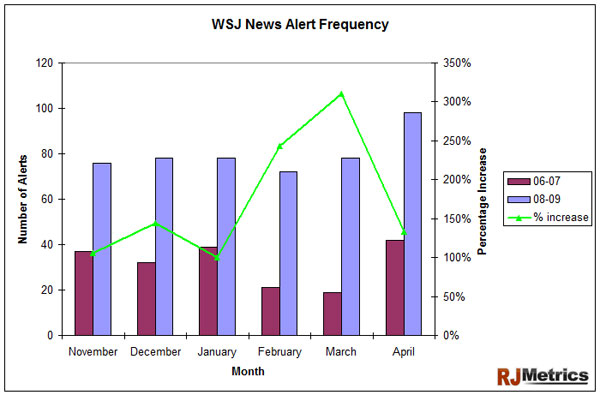Nothing makes me happier than a clean Inbox. I also love getting The Wall Street Journal’s online edition in my e-mail every morning (so much so that I pay for it). Lately, however, I’m having a hard time keeping these two joys in check with each other.
Subscribing to “The Online Journal” costs just over $100 per year and provides access to the online edition of the daily paper, a daily e-mail with links to each day’s articles, and the occasional “WSJ News Alert” to cover breaking news that occurs between daily editions.
In the past few months, however, I’ve noticed that the frequency of these occasional ”News Alerts” has increased quite a bit. In fact, I looked back and realized that on some days I get as many as five or six of them. It’s always technically some kind of news, but it’s almost never “Alert”-worthy anymore. Here are a few of my recent favorites:
- June 4: “United Plans Huge Jet Order”
- June 2: “Guggenheim Is Next Job for Bear’s Final CEO”
- May 25: WSJ’s Annual Ranking of Top Stock Analysts Released
- May 18: U.S. to Require 35 mpg Fuel-Economy Standard No Later Than 2016
- July 21 ’08: Alex Rodriguez signs with the William Morris Agency
Yes, this is news to somebody (in most cases), but it’s hardly news that warrants a special e-mail outside of the daily edition. It’s not election results or a war declaration; it’s at best front-page, below-the-fold content.
I wanted to see if the rate of e-mails was actually increasing over time or if my sensitivity had just increased. Fortunately, I had several months of recent e-mails and an old Outlook PST file from mid-2007. Each data set held the same six full months worth of WSJ News Alerts (November through April), separated by two years. The volume over those two six-month periods is compared below:
Wow. In the past two years, monthly WSJ News Alert volume has seen a weighted-average increase of over 100%. This is obviously statistically significant, but just to be sure I ran a quick t-test on it and, as expected, got a super-low p-value of 0.000004 (any p-value of 0.05 or lower would demonstrate a generally accepted measure of significance).
Also interesting is that the month-to-month volatility in e-mail volume has decreased considerably. In the 2006-2007 period, the standard deviation in monthly e-mail frequency was 30.3% of the average month’s volume (showing some degree of randomness, which would be expected with ”Alert”-worthy news). During the same period in 2008-2009, however, the standard deviation was only 11.4% of the average month. In fact, three of the six months in the more recent period had exactly 78 News Alert e-mails. That’s pretty remarkable consistency for what should be random news events!
This is heading in a pretty obvious direction: the WSJ now appears to have some kind of (very high) quota for monthly e-mail alerts. Why would they do this? Well, I opened one of these e-mails and there it was: an ad. These puppies are sponsored. For those of you who haven’t already seen where this is going, let me share a basic formula:
(Number of E-Mails) x (Number of Subscribers) = (Advertising Inventory) = $$$
It appears that the WSJ has pre-sold a set amount of direct e-mail advertising inventory (or at least has some expectation of monthly revenue from that channel), and they need to fill it whether there is news to report or not. This means that loyal (paying!) subscribers like me get stuck with one to six unnecessary WSJ News Alert e-mails (or should I say “ad delivery mechanisms”) a day.
I understand the need for increased monetization these days (especially in the print industry), but this is a bad move. Paying online subscribers like me are pure margin and represent the industry’s best chance of survival in the digital age. Why risk my $100/year subscription for a few extra cents worth of ad inventory?
It’s probably also worth pointing out that The Wall Street Journal’s Owner, Dow Jones, was acquired by News Corporation in August 2007. Coincidentally, my two data sets are from before and after the acquisition, respectively. I’m not suggesting that News Corp mandated this change, but the timing does line up rather conspicuously.
Or, maybe The WSJ picked up a few pointers from another News Corp subsidiary: Fox News. After all, these e-mails are the online equivalent of the “Breaking News” banner that cable news networks use to lure in channel-flipping viewers even when the news that’s breaking isn’t all that interesting or important. To me, breaking news is about a plane crash or peace accord. To Fox News and their rivals like MSNBC, it’s about… well, just about anything:
Granted, I’m sure this tactic works to some degree. If a channel surfer sees the “breaking news” banner, he or she is probably more likely to stay on the channel for at least a few seconds more. This increases the likelihood that they get sucked in and stay on the channel (and maybe even see an ad or two). Similarly, a “News Alert” e-mail probably increases the open rate, increasing the chance that the reader sees the ad in the e-mail, yielding more value to the advertiser (who is probably paying a premium CPM to access people like me who are known to pay for digital content).
However, overuse of this tactic is akin to crying wolf. At some point the consumer becomes desensitized and flips right by the “Breaking News” graphic or filters the “News Alert” e-mails straight to his or her trash can. I’ve hit this point for sure, and it’s causing me to get less value out of a paid service, which increases my likelihood of churning off as a subscriber.
I remain a huge fan of The Journal, but someone in their online department is making some big mistakes. Given my experiences with numerous publishers (online and off), I also know that they aren’t the only ones. Publishers, listen up: if that clever new revenue stream comes at the cost of your content’s quality or your reputation, it’s rarely the right long-term move. I expected better from my favorite paper.


